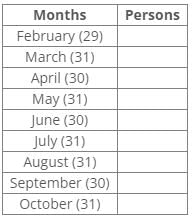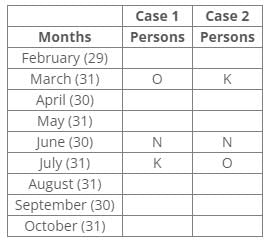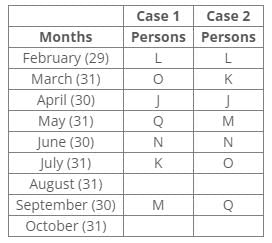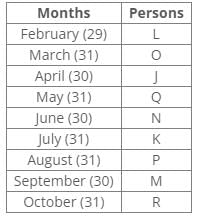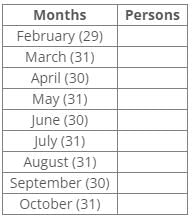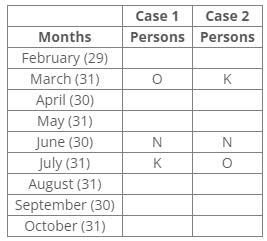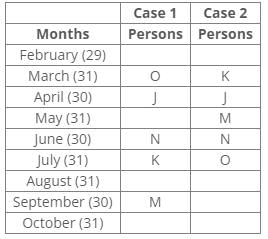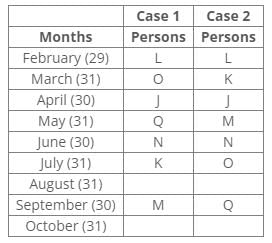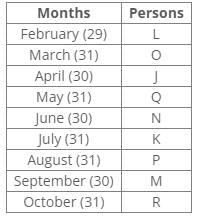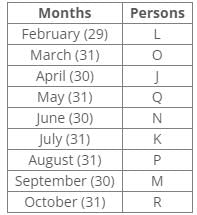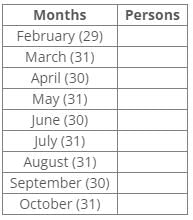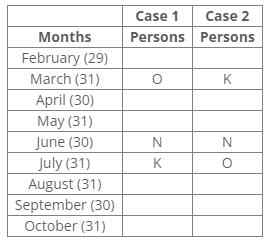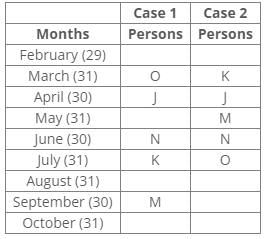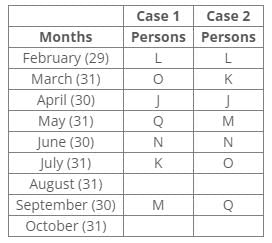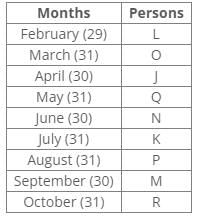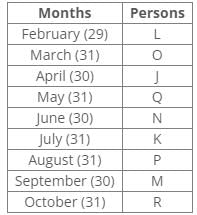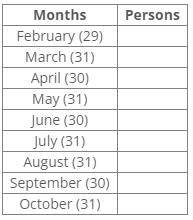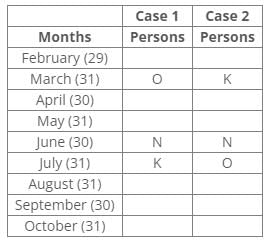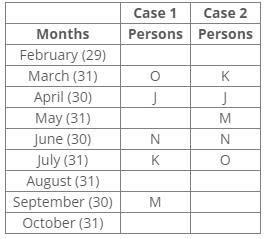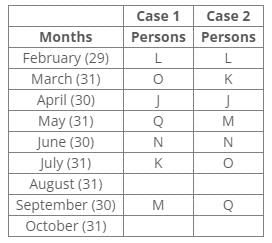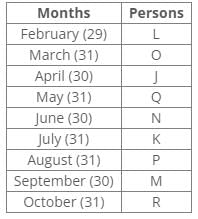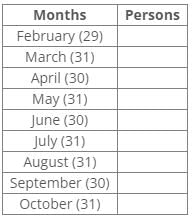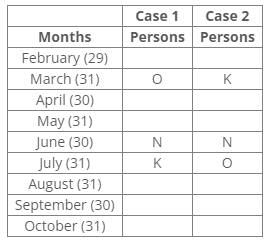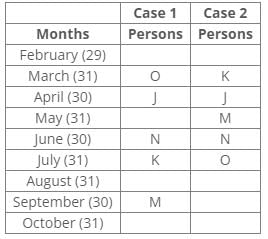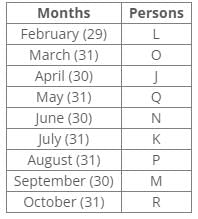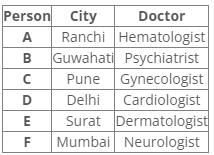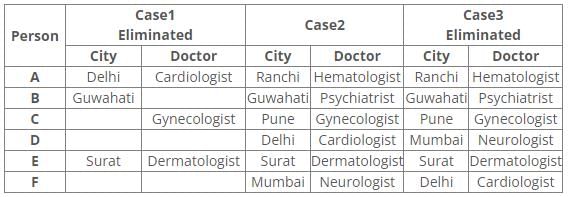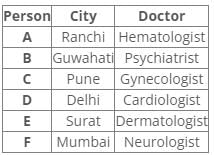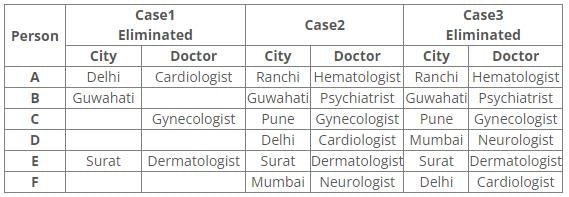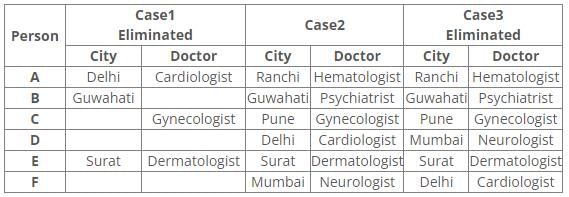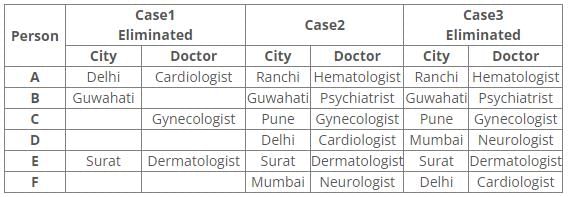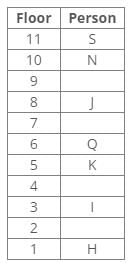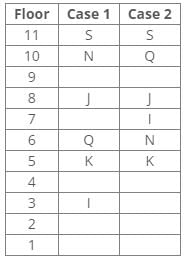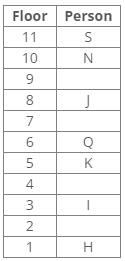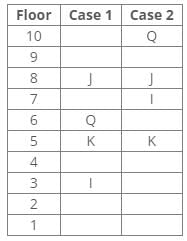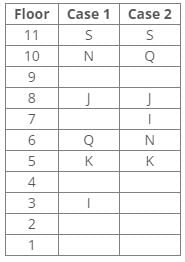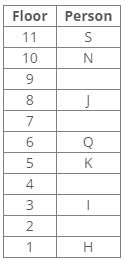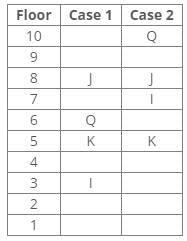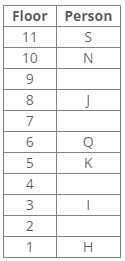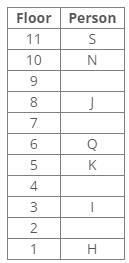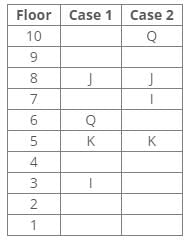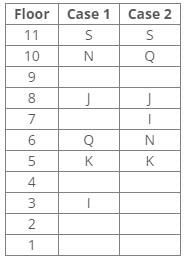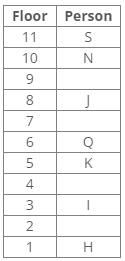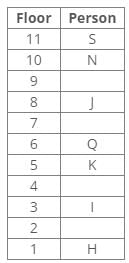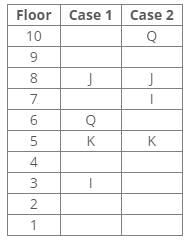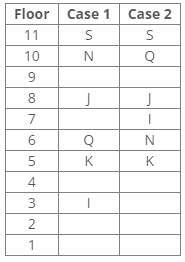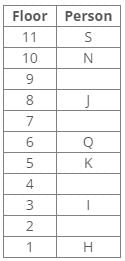MCQ: Puzzles- 3 - SSC CGL MCQ
15 Questions MCQ Test - MCQ: Puzzles- 3
Direction: Read the following information carefully and answer the questions given below.
Nine people J, K, L, M, N, O, P, Q and R were born on the 13th of nine different months of the year 2000 but not necessarily in the same order. No one was born after October and none of them was born in January. Only one person was born in one month. For all calculations of ages use 2022 as the current year.
P was born before R. The number of persons born between P and Q is the same as the number of persons born between Q and L. Three persons were born between O and K, where both were born in a month having 31 days. The number of persons born before N is the same as the number of persons born after N. The number of persons born between O and N is the same as the number of persons born between N and M. J was born in the month having 30 days, but not in September. The number of persons born after K is the same as the number of persons born before Q. L was born in the month having days less than 31.
Q. How many persons are elder than Q?
Nine people J, K, L, M, N, O, P, Q and R were born on the 13th of nine different months of the year 2000 but not necessarily in the same order. No one was born after October and none of them was born in January. Only one person was born in one month. For all calculations of ages use 2022 as the current year.
Q. How many persons are elder than Q?
Direction: Read the following information carefully and answer the questions given below.
Nine people J, K, L, M, N, O, P, Q and R were born on the 13th of nine different months of the year 2000 but not necessarily in the same order. No one was born after October and none of them was born in January. Only one person was born in one month. For all calculations of ages use 2022 as the current year.
P was born before R. The number of persons born between P and Q is the same as the number of persons born between Q and L. Three persons were born between O and K, where both were born in a month having 31 days. The number of persons born before N is the same as the number of persons born after N. The number of persons born between O and N is the same as the number of persons born between N and M. J was born in the month having 30 days, but not in September. The number of persons born after K is the same as the number of persons born before Q. L was born in the month having days less than 31.
Q. Which of the following is the eldest person?
Nine people J, K, L, M, N, O, P, Q and R were born on the 13th of nine different months of the year 2000 but not necessarily in the same order. No one was born after October and none of them was born in January. Only one person was born in one month. For all calculations of ages use 2022 as the current year.
Q. Which of the following is the eldest person?
Direction: Read the following information carefully and answer the questions given below.
Nine people J, K, L, M, N, O, P, Q and R were born on the 13th of nine different months of the year 2000 but not necessarily in the same order. No one was born after October and none of them was born in January. Only one person was born in one month. For all calculations of ages use 2022 as the current year.
P was born before R. The number of persons born between P and Q is the same as the number of persons born between Q and L. Three persons were born between O and K, where both were born in a month having 31 days. The number of persons born before N is the same as the number of persons born after N. The number of persons born between O and N is the same as the number of persons born between N and M. J was born in the month having 30 days, but not in September. The number of persons born after K is the same as the number of persons born before Q. L was born in the month having days less than 31.
Q. Who was born in April?
Nine people J, K, L, M, N, O, P, Q and R were born on the 13th of nine different months of the year 2000 but not necessarily in the same order. No one was born after October and none of them was born in January. Only one person was born in one month. For all calculations of ages use 2022 as the current year.
Q. Who was born in April?
Direction: Read the following information carefully and answer the questions given below.
Nine people J, K, L, M, N, O, P, Q and R were born on the 13th of nine different months of the year 2000 but not necessarily in the same order. No one was born after October and none of them was born in January. Only one person was born in one month. For all calculations of ages use 2022 as the current year.
P was born before R. The number of persons born between P and Q is the same as the number of persons born between Q and L. Three persons were born between O and K, where both were born in a month having 31 days. The number of persons born before N is the same as the number of persons born after N. The number of persons born between O and N is the same as the number of persons born between N and M. J was born in the month having 30 days, but not in September. The number of persons born after K is the same as the number of persons born before Q. L was born in the month having days less than 31.
Q. Which of the following statement is false?
Direction: Read the following information carefully and answer the questions given below.
Nine people J, K, L, M, N, O, P, Q and R were born on the 13th of nine different months of the year 2000 but not necessarily in the same order. No one was born after October and none of them was born in January. Only one person was born in one month. For all calculations of ages use 2022 as the current year.
P was born before R. The number of persons born between P and Q is the same as the number of persons born between Q and L. Three persons were born between O and K, where both were born in a month having 31 days. The number of persons born before N is the same as the number of persons born after N. The number of persons born between O and N is the same as the number of persons born between N and M. J was born in the month having 30 days, but not in September. The number of persons born after K is the same as the number of persons born before Q. L was born in the month having days less than 31.
Q. Four of the following five are alike in a certain way thus formed a group. Which of the following is not the part of the group?
Direction: Study the following information and answer the given questions carefully.
Six people A, B, C, D, E and F have an appointment with different doctors i.e. Neurologist, Cardiologist, Dermatologist, Hematologist, Gynecologist and Psychiatrist in different cities i.e. Pune, Mumbai, Delhi, Guwahati, Surat and Ranchi but not necessarily in the same order.
C is neither going to Mumbai nor Surat. Dermatologist is in Surat. Cardiologist is in Delhi. F has an appointment with either Neurologist or Psychiatrist. C has an appointment with Gynecologist. Psychiatrist is not in Mumbai. B has appointment in Guwahati. Neither D nor F has an appointment with Hematologist, who is in Ranchi. E has an appointment in Surat.
Q. Who has an appointment with Cardiologist?
Direction: Study the following information and answer the given questions carefully.
Six people A, B, C, D, E and F have an appointment with different doctors i.e. Neurologist, Cardiologist, Dermatologist, Hematologist, Gynecologist and Psychiatrist in different cities i.e. Pune, Mumbai, Delhi, Guwahati, Surat and Ranchi but not necessarily in the same order.
C is neither going to Mumbai nor Surat. Dermatologist is in Surat. Cardiologist is in Delhi. F has an appointment with either Neurologist or Psychiatrist. C has an appointment with Gynecologist. Psychiatrist is not in Mumbai. B has appointment in Guwahati. Neither D nor F has an appointment with Hematologist, who is in Ranchi. E has an appointment in Surat.
Q. Who has an appointment in Ranchi?
Direction: Study the following information and answer the given questions carefully.
Six people A, B, C, D, E and F have an appointment with different doctors i.e. Neurologist, Cardiologist, Dermatologist, Hematologist, Gynecologist and Psychiatrist in different cities i.e. Pune, Mumbai, Delhi, Guwahati, Surat and Ranchi but not necessarily in the same order.
C is neither going to Mumbai nor Surat. Dermatologist is in Surat. Cardiologist is in Delhi. F has an appointment with either Neurologist or Psychiatrist. C has an appointment with Gynecologist. Psychiatrist is not in Mumbai. B has appointment in Guwahati. Neither D nor F has an appointment with Hematologist, who is in Ranchi. E has an appointment in Surat.
Q. In which city Psychiatrist is?
Direction: Study the following information and answer the given questions carefully.
Six people A, B, C, D, E and F have an appointment with different doctors i.e. Neurologist, Cardiologist, Dermatologist, Hematologist, Gynecologist and Psychiatrist in different cities i.e. Pune, Mumbai, Delhi, Guwahati, Surat and Ranchi but not necessarily in the same order.
C is neither going to Mumbai nor Surat. Dermatologist is in Surat. Cardiologist is in Delhi. F has an appointment with either Neurologist or Psychiatrist. C has an appointment with Gynecologist. Psychiatrist is not in Mumbai. B has appointment in Guwahati. Neither D nor F has an appointment with Hematologist, who is in Ranchi. E has an appointment in Surat.
Q. F has an appointment with ________ in ________.
Direction: Study the following information and answer the given questions carefully.
Six people A, B, C, D, E and F have an appointment with different doctors i.e. Neurologist, Cardiologist, Dermatologist, Hematologist, Gynecologist and Psychiatrist in different cities i.e. Pune, Mumbai, Delhi, Guwahati, Surat and Ranchi but not necessarily in the same order.
C is neither going to Mumbai nor Surat. Dermatologist is in Surat. Cardiologist is in Delhi. F has an appointment with either Neurologist or Psychiatrist. C has an appointment with Gynecologist. Psychiatrist is not in Mumbai. B has appointment in Guwahati. Neither D nor F has an appointment with Hematologist, who is in Ranchi. E has an appointment in Surat.
Q. Choose the incorrect pair.
Direction: Study the following information and answer the given questions carefully.
A certain number of people live on different floors of a building, where the bottommost floor is numbered 1 and the floor above it is 2 and so on. There is no vacant floor in the building.
J lives three floors above K. One person lives between J and N. The number of persons living between Q and K is equal to the number of persons living between N and S. The number of persons living below H is equal to the number of persons living above S. Q lives three floors above I. The number of persons living between I and N is one less than the number of persons living below J. K lives on the 5th floor. S doesn’t live on a perfect square-numbered floor. One person lives between I and H. One person lives between Q and J.
Q. How many persons live below the person who lives three floors below J?
Direction: Study the following information and answer the given questions carefully.
A certain number of people live on different floors of a building, where the bottommost floor is numbered 1 and the floor above it is 2 and so on. There is no vacant floor in the building.
J lives three floors above K. One person lives between J and N. The number of persons living between Q and K is equal to the number of persons living between N and S. The number of persons living below H is equal to the number of persons living above S. Q lives three floors above I. The number of persons living between I and N is one less than the number of persons living below J. K lives on the 5th floor. S doesn’t live on a perfect square-numbered floor. One person lives between I and H. One person lives between Q and J.
Q. Who lives on 8th floor?
Direction: Study the following information and answer the given questions carefully.
A certain number of people live on different floors of a building, where the bottommost floor is numbered 1 and the floor above it is 2 and so on. There is no vacant floor in the building.
J lives three floors above K. One person lives between J and N. The number of persons living between Q and K is equal to the number of persons living between N and S. The number of persons living below H is equal to the number of persons living above S. Q lives three floors above I. The number of persons living between I and N is one less than the number of persons living below J. K lives on the 5th floor. S doesn’t live on a perfect square-numbered floor. One person lives between I and H. One person lives between Q and J.
Q. How many persons live above N?
Direction: Study the following information and answer the given questions carefully.
A certain number of people live on different floors of a building, where the bottommost floor is numbered 1 and the floor above it is 2 and so on. There is no vacant floor in the building.
J lives three floors above K. One person lives between J and N. The number of persons living between Q and K is equal to the number of persons living between N and S. The number of persons living below H is equal to the number of persons living above S. Q lives three floors above I. The number of persons living between I and N is one less than the number of persons living below J. K lives on the 5th floor. S doesn’t live on a perfect square-numbered floor. One person lives between I and H. One person lives between Q and J.
Q. How many persons live between S and Q?
Direction: Study the following information and answer the given questions carefully.
A certain number of people live on different floors of a building, where the bottommost floor is numbered 1 and the floor above it is 2 and so on. There is no vacant floor in the building.
J lives three floors above K. One person lives between J and N. The number of persons living between Q and K is equal to the number of persons living between N and S. The number of persons living below H is equal to the number of persons living above S. Q lives three floors above I. The number of persons living between I and N is one less than the number of persons living below J. K lives on the 5th floor. S doesn’t live on a perfect square-numbered floor. One person lives between I and H. One person lives between Q and J.
Q. Who among the following one lives on the bottommost floor?



